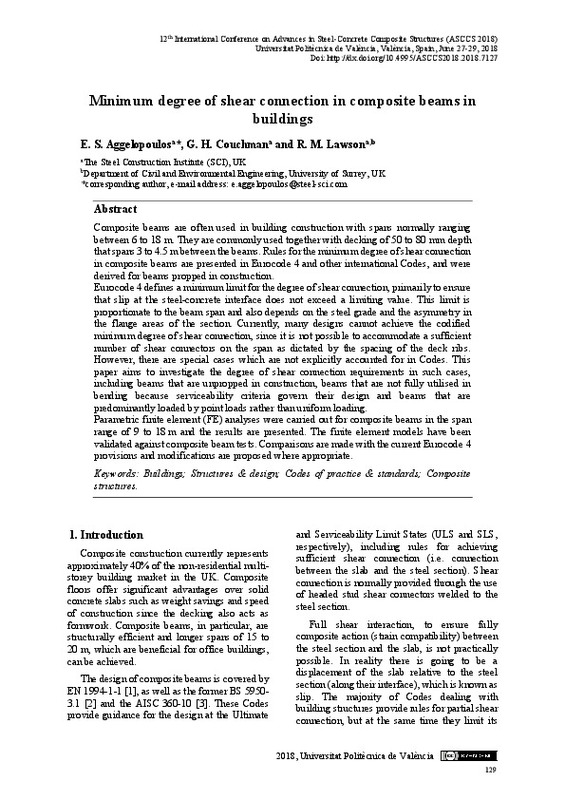JavaScript is disabled for your browser. Some features of this site may not work without it.
Buscar en RiuNet
Listar
Mi cuenta
Estadísticas
Ayuda RiuNet
Admin. UPV
Minimum degree of shear connection in composite beams in buildings
Mostrar el registro sencillo del ítem
Ficheros en el ítem
| dc.contributor.author | Aggelopoulos, Eleftherios
|
es_ES |
| dc.contributor.author | Couchman, Graham
|
es_ES |
| dc.contributor.author | Lawson, Mark
|
es_ES |
| dc.date.accessioned | 2018-10-04T06:58:49Z | |
| dc.date.available | 2018-10-04T06:58:49Z | |
| dc.date.issued | 2018-06-05 | |
| dc.identifier.isbn | 9788490486016 | |
| dc.identifier.uri | http://hdl.handle.net/10251/109213 | |
| dc.description.abstract | [EN] Composite floors are often used in building construction where beams typically span from 6 to 18 m. They are commonly used together with decking of 50 to 80 mm depth that spans 3 to 4.5 m between the beams. Rules for the minimum degree of shear connection in composite beams are presented in Eurocode 4 and other international Codes, and were derived for beams in propped construction.Eurocode 4 defines a minimum limit for the degree of shear connection, primarily to ensure that slip at the steel-concrete interface does not exceed a limiting value. This limit is proportionate to the beam span and also depends on the steel strength and the asymmetry of the flange areas of the section. Currently, many designs cannot achieve the codified degree of shear connection demands, since it is not possible to accommodate a sufficient number of shear connectors on the span as dictated by the spacing of the deck ribs. However, there are special cases which are not explicitly accounted for in Codes. This paper aims to investigate the degree of shear connection requirements in such cases, including beams that are unpropped in construction, beams that are not fully utilised in bending because serviceability criteria govern their design and beams that are predominantly loaded by point loads rather than uniform loading.The results from parametric finite element analyses carried out using ANSYS for beams in the span range of 6 to 18 m are presented. The finite element models have been calibrated against composite beam tests. Comparisons are made with the current Eurocode 4 provisions and modifications are proposed where appropriate. | es_ES |
| dc.format.extent | 7 | es_ES |
| dc.language | Inglés | es_ES |
| dc.publisher | Editorial Universitat Politècnica de València | es_ES |
| dc.relation.ispartof | Proceedings of the 12th International Conference on Advances in Steel-Concrete Composite Structures. ASCCS 2018 | es_ES |
| dc.rights | Reconocimiento - No comercial - Sin obra derivada (by-nc-nd) | es_ES |
| dc.subject | Buildings | es_ES |
| dc.subject | Structures and design | es_ES |
| dc.subject | Codes of practice and standards | es_ES |
| dc.subject | Composite structures | es_ES |
| dc.title | Minimum degree of shear connection in composite beams in buildings | es_ES |
| dc.type | Capítulo de libro | es_ES |
| dc.type | Comunicación en congreso | es_ES |
| dc.identifier.doi | 10.4995/ASCCS2018.2018.7127 | |
| dc.rights.accessRights | Abierto | es_ES |
| dc.description.bibliographicCitation | Aggelopoulos, E.; Couchman, G.; Lawson, M. (2018). Minimum degree of shear connection in composite beams in buildings. En Proceedings of the 12th International Conference on Advances in Steel-Concrete Composite Structures. ASCCS 2018. Editorial Universitat Politècnica de València. 129-135. https://doi.org/10.4995/ASCCS2018.2018.7127 | es_ES |
| dc.description.accrualMethod | OCS | es_ES |
| dc.relation.conferencename | 12th international conference on ‘Advances in Steel-Concrete Composite Structures’ - ASCCS 2018 | es_ES |
| dc.relation.conferencedate | Junio 27-29,2018 | es_ES |
| dc.relation.conferenceplace | Valencia, Spain | es_ES |
| dc.relation.publisherversion | http://ocs.editorial.upv.es/index.php/ASCCS/ASCCS2018/paper/view/7127 | es_ES |
| dc.description.upvformatpinicio | 129 | es_ES |
| dc.description.upvformatpfin | 135 | es_ES |
| dc.type.version | info:eu-repo/semantics/publishedVersion | es_ES |
| dc.relation.pasarela | OCS\7127 | es_ES |








